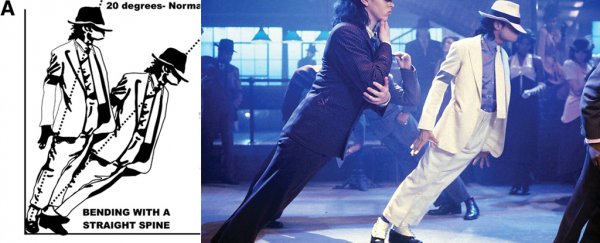In 1987, the music video Smooth Criminal by Michael Jackson stunned audiences around the world with a gravity-defying move – leaning forward to a staggering 45 degree angle.
There was some footwear magic happening there, for sure - but a group of neuroscientists have looked at the spine biomechanics behind the technique he performed in concerts all over the world. And nope, Michael Jackson really didn't need wires.
"MJ pulled off a gravity-defying 45 degree move that seems unearthly to any witness. Several MJ fans, including the authors, have tried to copy this move and failed, often injuring themselves in their endeavours," the researchers wrote in their paper.
Now, it's not exactly a secret that MJ had help performing the stunt. The illusion was aided with a nail that popped up at just the right moment and hitched into a special shoe.
This gave him extra grip to a floor that he would otherwise fall down on - but his body played a huge role, too.
"As much as we would like to believe that MJ broke the relationship between physiology and physics, a patent registered under his name shows that the move was accomplished with a clever invention," the researchers, from the Postgraduate Institute of Medical Education and Research in India, wrote.
"But even with specially designed footwear and the support of the hitch member, the move is incredibly hard to pull off, requiring athletic core strength from strengthened spinal muscles and lower-limb antigravity muscles."
In fact, the researchers found that MJ kept most of the strain of the pose in his Achilles heel. Without the shoes, even extremely fit professional dancers could only do a maximum lean of 25 to 30 degrees.
Basically, don't bother trying this at home, you'll probably hurt yourself.
You can see the gravity-defying lean live on stage, and the mechanism behind it, in the video below.
But the real question the researchers were looking into was how Michael Jackson challenged our understanding of spine biomechanics. According to this team, he definitely played a role.
"Trick or not, new forms of dancing inspired by MJ have begun to challenge our understanding of the modes and mechanisms of spinal injury," the researchers wrote.
"Ever since MJ entertained us with his fabulous moves, throughout the world dancers have tried to jump higher, stretch farther, and turn faster than ever before."
Of course, this leads into why this article was written in the first place – to determine how spine surgeries for dancers may change in the future.
"The rapid rise in popularity of dance as an art and exercise the world over is bound to produce new forms of injuries that may perplex the neurosurgeon. The art of movement is life itself for many dancers, and it remains to be seen how surgical implants will hold up to the stresses of dance," they concluded.
"While many new questions need answering, what is certain is that all this is owed to the ever-fresh inventiveness and style of 'The King of Pop'."
The research has been published in the Journal of Neurosurgery: Spine.
